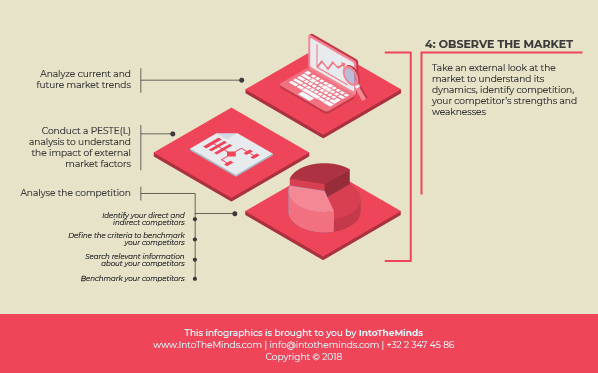
How to do market research? This is the question we’re helping you to answer with the publication of our online step-by-step guide to market research. Each of the 7 phases of our market research methodology is accompanied by a post on this blog. Today we’ll be dealing with Phase 4: the PESTEL analysis and the competition analysis.
READ PHASE 4 OF OUR MARKET RESEARCH METHODOLOGY
If you missed the latest episodes you can find them back here :
- Phase 1 : putting his/her business idea on paper and the Design Thinking session
- Phase 2 : improving the original business idea
- Phase 3 : choosing the right market research methods
Phase 4 focuses on using secondary sources to get a better understanding of the market dynamics. We have given in a previous feature article a list (non-exhaustive of course) of these sources. To this aim we’ll introduce you to 2 types of analysis: the PESTEL analysis and the competition analysis.

The PESTEL analysis
PESTEL is an acronym which means Political – Economic – Sociological – Technological – Ecological – Legal. This acronym is, therefore, a mnemonic to remind you of the different types of factors that can influence your market.
Note that the analysis has been extended in recent years to other factors that may have an impact on your market: demographics, culture, ethics and ecology. These aspects, which are becoming increasingly topical, will be essential to consider to avoid missteps.
The PESTEL analysis will, therefore, consist of evaluating the effect of these factors on your market, knowing that they are all beyond your control. Here are a few examples:
How might political decisions affect your project? Which legislative proposals could have an influence (positive or negative)? Are there economic or legal constraints that may affect you? For example, are economic conditions and legal restrictions conducive to the development of your business? The degree of technological maturity of a country is essential to assess if you want to launch an innovation. Will consumers be ready to accept it?
A systematic PESTEL analysis will allow you to cover all these factors and identify threats and opportunities for your project’s success well in advance. Below are slides from a course we have given on the subject, which will no doubt help you to go deeper into the matter.
The competition analysis
Competition analysis is also part of phase 4 as it can be based on secondary information (books, websites, financial statements, academic studies, professional reports, and so on, …).
Competitive analysis is essential. It can take different forms: fieldwork, qualitative or quantitative analysis, and can be synthesised in various ways: SWOT or Porter’s 5 forces analysis, for example. In any case, it must be carried out as objectively as possible to eliminate possible biases from your conclusions and to report as accurately as possible on the obstacles you will face when entering the market. Our online guide will help you to find the right sources of information and the proper methods to carry it out.
Don’t hesitate to comment this post on Twitter, Linkedin, Facebook or more simply at the bottom of this page.
Posted in Marketing.

